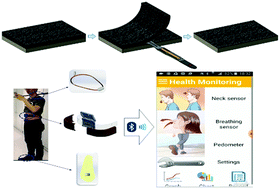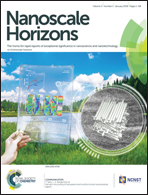Sliced graphene foam films for dual-functional wearable strain sensors and switches†
Abstract
The demand for wearable sensors is growing in many emerging fields, such as health monitoring, human-machine interfaces, robotics and personalized medicine. Here, we report the integration of skin-mountable, flexible, stretchable, dual-functional sensors and switches together with silicon-based electronics to create a novel healthcare system. We employ a facile approach to design highly stretchable graphene foam (GF)/PDMS composite films with tunable sensitivities and switching capabilities by simply controlling the thickness of GF. The GF/PDMS composite films deliver a high gauge factor of 24 at a 10% strain, tunable stretchability up to 70% and an excellent on/off switching ratio on the order of 1000. The highly reversible switching capability of the composite films is realized by identifying abnormal resistance changes at strains beyond a threshold value. To bridge the gap between signal transmission, wireless communication and post-processing in wearable devices, the sensors are combined with electronics, allowing data transmission to a smartphone using a custom-developed application consisting of a user-friendly interface. The novel approaches reported here offer a wide range of practical applications, including medical diagnosis, health monitoring and patient healthcare.



 Please wait while we load your content...
Please wait while we load your content...